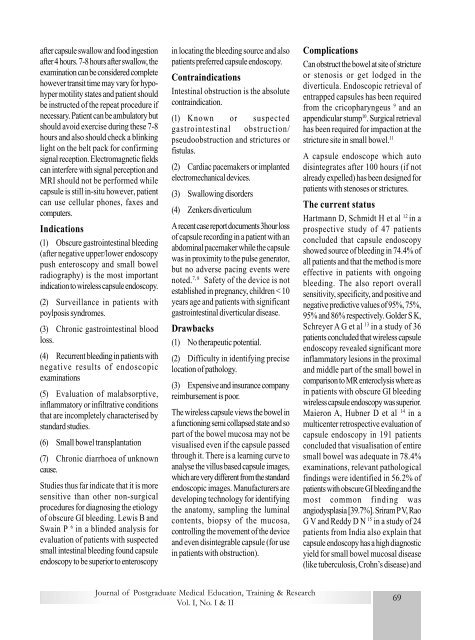Journal 1pages FINAL 34- - National Board Of Examination
Journal 1pages FINAL 34- - National Board Of Examination
Journal 1pages FINAL 34- - National Board Of Examination
Create successful ePaper yourself
Turn your PDF publications into a flip-book with our unique Google optimized e-Paper software.
after capsule swallow and food ingestionafter 4 hours. 7-8 hours after swallow, theexamination can be considered completehowever transit time may vary for hypohypermotility states and patient shouldbe instructed of the repeat procedure ifnecessary. Patient can be ambulatory butshould avoid exercise during these 7-8hours and also should check a blinkinglight on the belt pack for confirmingsignal reception. Electromagnetic fieldscan interfere with signal perception andMRI should not be performed whilecapsule is still in-situ however, patientcan use cellular phones, faxes andcomputers.Indications(1) Obscure gastrointestinal bleeding(after negative upper/lower endoscopypush enteroscopy and small bowelradiography) is the most importantindication to wireless capsule endoscopy.(2) Surveillance in patients withpoylposis syndromes.(3) Chronic gastrointestinal bloodloss.(4) Recurrent bleeding in patients withnegative results of endoscopicexaminations(5) Evaluation of malabsorptive,inflammatory or infiltrative conditionsthat are incompletely characterised bystandard studies.(6) Small bowel transplantation(7) Chronic diarrhoea of unknowncause.Studies thus far indicate that it is moresensitive than other non-surgicalprocedures for diagnosing the etiologyof obscure GI bleeding. Lewis B andSwain P 6 in a blinded analysis forevaluation of patients with suspectedsmall intestinal bleeding found capsuleendoscopy to be superior to enteroscopyin locating the bleeding source and alsopatients preferred capsule endoscopy.ContraindicationsIntestinal obstruction is the absolutecontraindication.(1) Known or suspectedgastrointestinal obstruction/pseudoobstruction and strictures orfistulas.(2) Cardiac pacemakers or implantedelectromechanical devices.(3) Swallowing disorders(4) Zenkers diverticulumA recent case report documents 3hour lossof capsule recording in a patient with anabdominal pacemaker while the capsulewas in proximity to the pulse generator,but no adverse pacing events werenoted. 7, 8 Safety of the device is notestablished in pregnancy, children < 10years age and patients with significantgastrointestinal diverticular disease.Drawbacks(1) No therapeutic potential.(2) Difficulty in identifying preciselocation of pathology.(3) Expensive and insurance companyreimbursement is poor.The wireless capsule views the bowel ina functioning semi collapsed state and sopart of the bowel mucosa may not bevisualised even if the capsule passedthrough it. There is a learning curve toanalyse the villus based capsule images,which are very different from the standardendoscopic images. Manufacturers aredeveloping technology for identifyingthe anatomy, sampling the luminalcontents, biopsy of the mucosa,controlling the movement of the deviceand even disintegrable capsule (for usein patients with obstruction).ComplicationsCan obstruct the bowel at site of strictureor stenosis or get lodged in thediverticula. Endoscopic retrieval ofentrapped capsules has been requiredfrom the cricopharyngeus 9 and anappendicular stump 10 . Surgical retrievalhas been required for impaction at thestricture site in small bowel. 11A capsule endoscope which autodisintegrates after 100 hours (if notalready expelled) has been designed forpatients with stenoses or strictures.The current statusHartmann D, Schmidt H et al 12 in aprospective study of 47 patientsconcluded that capsule endoscopyshowed source of bleeding in 74.4% ofall patients and that the method is moreeffective in patients with ongoingbleeding. The also report overallsensitivity, specificity, and positive andnegative predictive values of 95%, 75%,95% and 86% respectively. Golder S K,Schreyer A G et al 13 in a study of 36patients concluded that wireless capsuleendoscopy revealed significant moreinflammatory lesions in the proximaland middle part of the small bowel incomparison to MR enteroclysis where asin patients with obscure GI bleedingwireless capsule endoscopy was superior.Maieron A, Hubner D et al 14 in amulticenter retrospective evaluation ofcapsule endoscopy in 191 patientsconcluded that visualisation of entiresmall bowel was adequate in 78.4%examinations, relevant pathologicalfindings were identified in 56.2% ofpatients with obscure GI bleeding and themost common finding wasangiodysplasia [39.7%]. Sriram P V, RaoG V and Reddy D N 15 in a study of 24patients from India also explain thatcapsule endoscopy has a high diagnosticyield for small bowel mucosal disease(like tuberculosis, Crohn’s disease) and<strong>Journal</strong> of Postgraduate Medical Education, Training & ResearchVol. I, No. I & II69
















